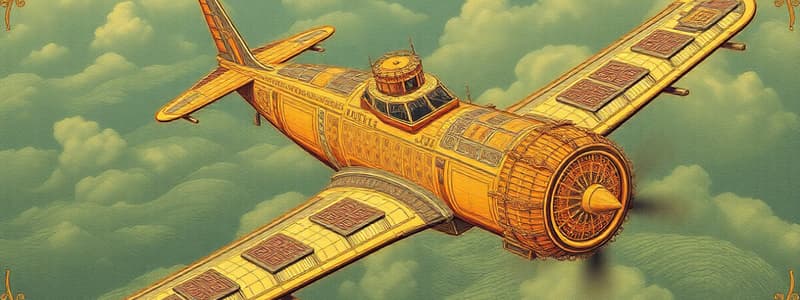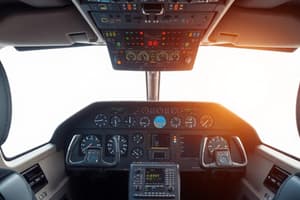Podcast
Questions and Answers
If an aircraft's ailerons are deflected asymmetrically (one up, one down), which axis of movement is primarily affected?
If an aircraft's ailerons are deflected asymmetrically (one up, one down), which axis of movement is primarily affected?
- Vertical axis, resulting in yaw.
- Longitudinal axis, resulting in roll. (correct)
- Lateral axis, resulting in pitch.
- A combination of all three axes equally.
During the approach for landing, a pilot deploys flaps. What is the primary effect of flaps deployment on the aircraft's flight characteristics?
During the approach for landing, a pilot deploys flaps. What is the primary effect of flaps deployment on the aircraft's flight characteristics?
- Improved lateral stability at higher speeds.
- Reduced drag, allowing for a steeper descent angle.
- Increased drag and lift, enabling slower flight. (correct)
- Decreased lift, requiring a higher approach speed.
A pilot is experiencing a consistent need to apply back pressure on the control column (yoke) to maintain level flight. How can the pilot utilize the trim system to alleviate this control pressure?
A pilot is experiencing a consistent need to apply back pressure on the control column (yoke) to maintain level flight. How can the pilot utilize the trim system to alleviate this control pressure?
- Use the elevator trim to relieve the pressure on the yoke. (correct)
- Increase engine power to reduce the required back pressure.
- Adjust the aileron trim to counter the adverse yaw.
- Apply rudder trim to maintain directional control.
Which combination of primary flight control surfaces is used to perform a coordinated turn?
Which combination of primary flight control surfaces is used to perform a coordinated turn?
An aircraft is flying in stable, level flight. What is the relationship between the three axes of movement and the center of gravity?
An aircraft is flying in stable, level flight. What is the relationship between the three axes of movement and the center of gravity?
A pilot notices the aircraft is yawing to the left without any rudder input. Which flight control would be used to counteract this?
A pilot notices the aircraft is yawing to the left without any rudder input. Which flight control would be used to counteract this?
What is the likely effect of extending flaps during the initial climb after takeoff if the aircraft's climb performance is already marginal?
What is the likely effect of extending flaps during the initial climb after takeoff if the aircraft's climb performance is already marginal?
A pilot wants to maintain a constant altitude without having to continuously apply pressure on the control column. Which control is most appropriate for achieving this?
A pilot wants to maintain a constant altitude without having to continuously apply pressure on the control column. Which control is most appropriate for achieving this?
During flight, what would be the effect of moving the control stick (or yoke) to the left?
During flight, what would be the effect of moving the control stick (or yoke) to the left?
What is the primary purpose of the rudder on an aircraft?
What is the primary purpose of the rudder on an aircraft?
Flashcards
Ailerons
Ailerons
Control the aircraft's roll (rotation around the longitudinal axis).
Elevator
Elevator
Control the aircraft's pitch (nose up or down movement).
Rudder
Rudder
Control the aircraft's yaw (left or right turning movement).
Flaps
Flaps
Signup and view all the flashcards
Trim
Trim
Signup and view all the flashcards
Longitudinal Axis
Longitudinal Axis
Signup and view all the flashcards
Lateral Axis
Lateral Axis
Signup and view all the flashcards
Vertical Axis
Vertical Axis
Signup and view all the flashcards
Study Notes
- Aircraft Flight Control Systems enable pilots to control the direction of an airplane.
- Airplanes are controlled across 3 axes: roll, pitch, and yaw.
Flight Control Types
- Flight controls are categorized as either primary or secondary.
Primary Flight Controls
- Ailerons: Control the roll of the aircraft (left or right).
- Elevator: Controls the pitch of the aircraft (up or down).
- Rudder: Controls the yaw of the aircraft (left or right).
- Ailerons and elevators are connected to the aircraft’s stick or yoke.
- The rudder is controlled via rudder pedals in the footwell.
Secondary Flight Controls
- Flaps: Increase the wing's lift, enabling slower flight, beneficial for takeoff and landing.
- Trim: Functions like cruise control, maintaining altitude by alleviating control pressures.
- Adjusting trim allows releasing pressure on the yoke while keeping the airplane at the same altitude.
Axis of Movement
- Airplanes move about three axes that meet at the CENTER OF GRAVITY.
- Longitudinal Axis: Runs from nose to tail; ailerons control roll around it.
- Lateral Axis: Runs from wingtip to wingtip; the elevator controls pitch.
- Vertical Axis: Runs vertically; the rudder controls yaw.
Studying That Suits You
Use AI to generate personalized quizzes and flashcards to suit your learning preferences.



